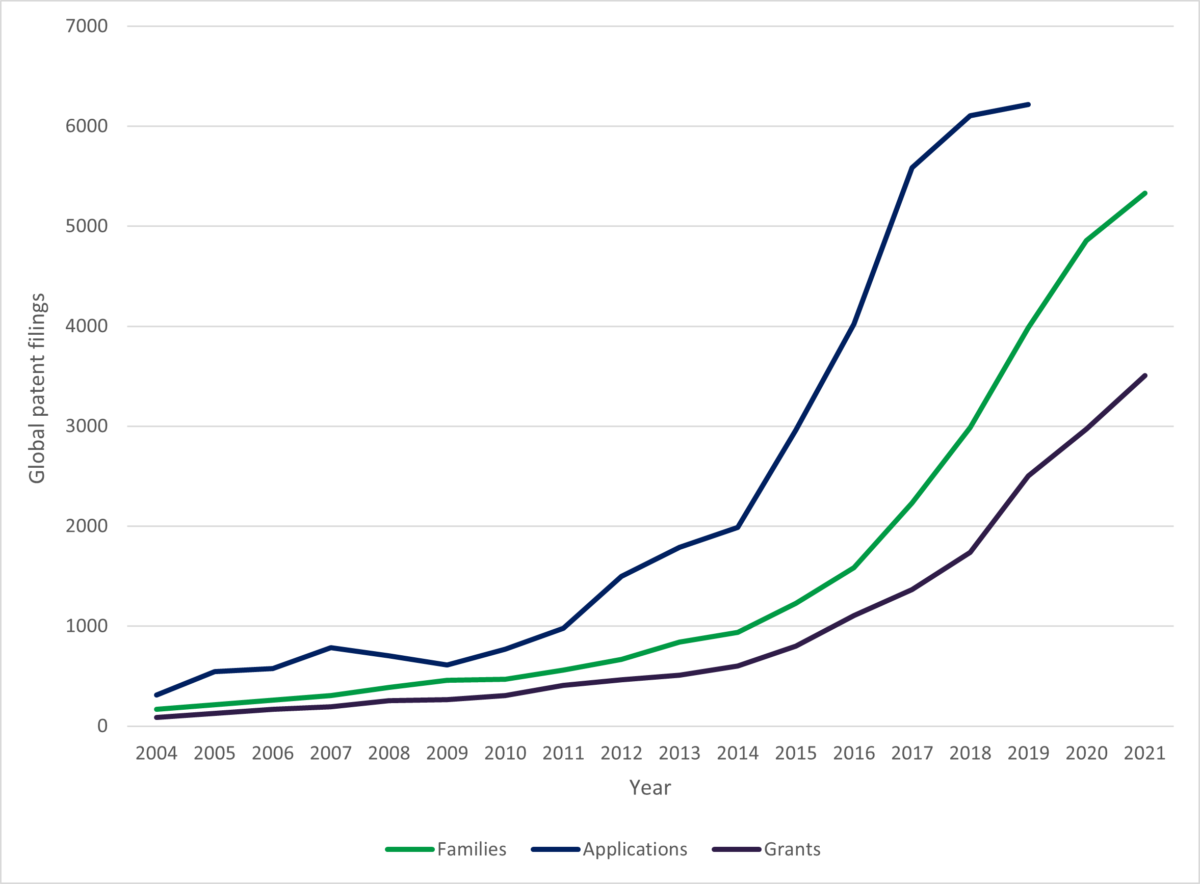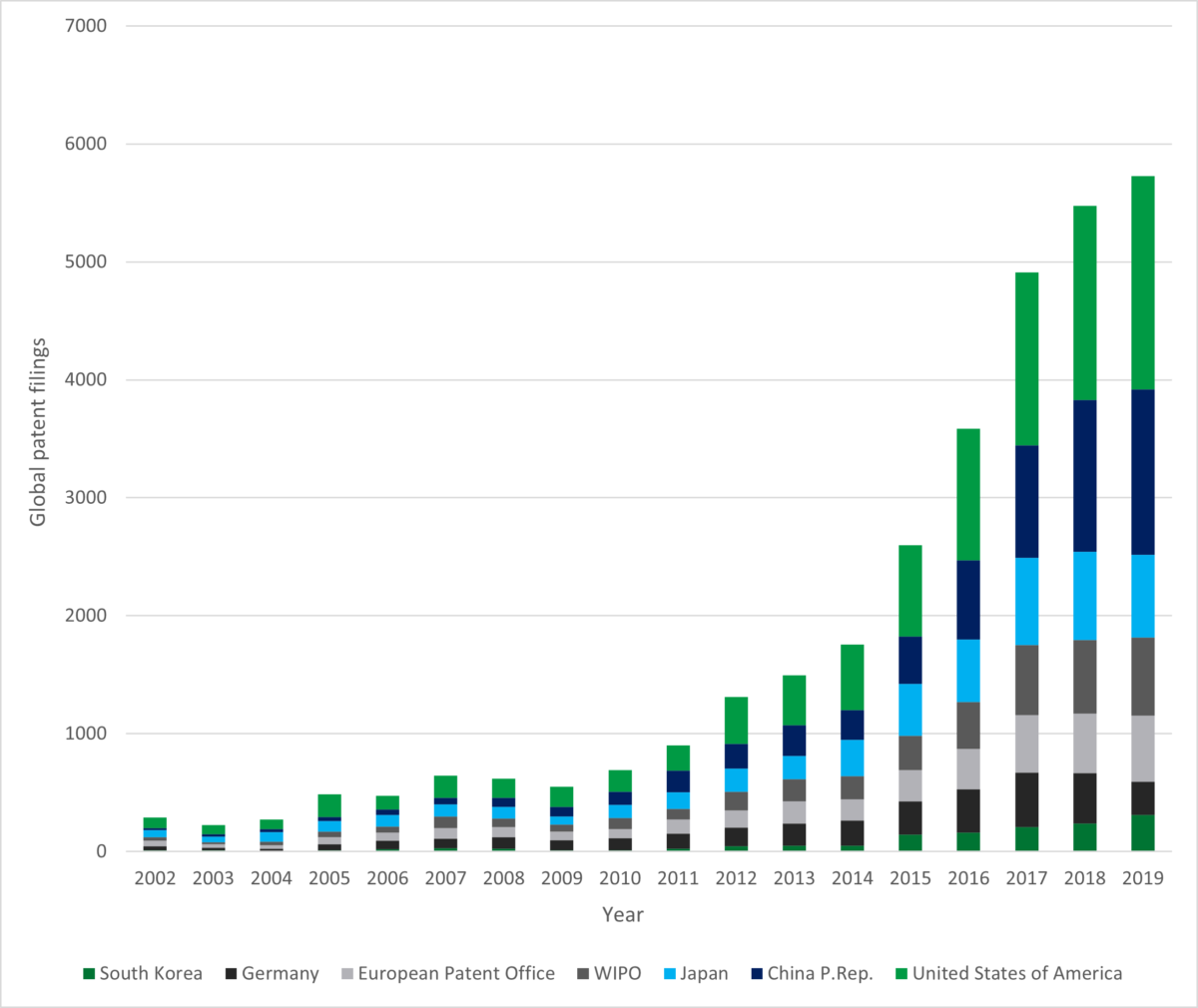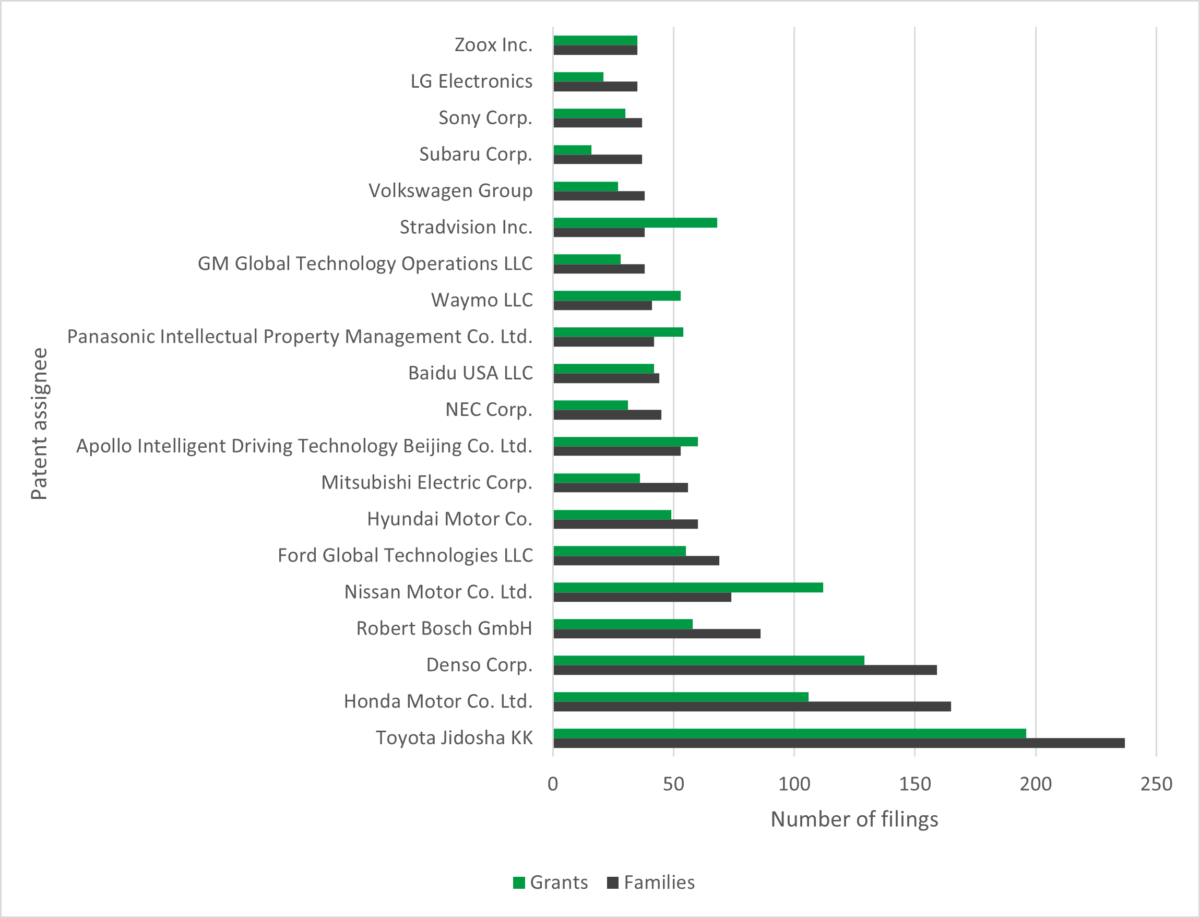About the authors:
Richard Bray is a partner and patent attorney. Richard works with a range of clients in technological sectors such as electronic consumer goods, defence, food products, and the more emerging technologies of autonomous vehicles, vehicular head-up displays, virtual and augmented reality, image guided therapy, nuclear (e.g. fusion), quantum security, and more.
Paul Roscoe is a senior associate and patent attorney. Paul has experience of subject-matter including engineering, electronics, and computer-implemented inventions, and in particular, artificial intelligence applications.
Tom Gregory is a trainee patent attorney. Tom’s work is primarily focused on the mechanics and electronics sectors. He also has valuable experience in computer-implemented inventions and software. Tom currently assists clients working in the fields of autonomous vehicles, defence and aerospace.
Key findings:
- Artificial intelligence (AI) patent filings in traffic and transportation engineering have been increasing in recent years, and have been accelerating since 2014.
- Over 5000 new patent families were published in 2021, compared with around 2000 in 2016.
- Interestingly, whilst it would be expected that transportation and traffic engineering companies (e.g., Siemens Mobility) would be present in the top 20 list of assignees, instead the list is primarily made up of automotive and tech companies. It will be interesting to see how these companies exercise their patent rights in the years to come, with the potential for extensive licensing of their patented technology, and collaboration with manufacturers of infrastructure.
Introduction
Artificial intelligence (AI), and machine learning, has gained much media attention of late. Various commentators have raised questions such as whether it is a fad, whether it can be trusted, and whether it will ultimately take over.
For us, as patent attorneys, we like to look at what the patent data can tell us. This field in particular is interesting because innovation in traffic and transportation engineering would appear pivotal to the successful roll-out of self-driving vehicles, and managing the ever-increasing number of vehicles on the roads. This may provide some indication as to the motivation of the automotive companies innovating in this field. However, the data does not tell us why infrastructure manufacturers are not using AI to solve existing challenges.
Below, we take a deeper dive into the patent data.
Patent Application Examples
The data used to compile the charts in this article include a wide-range of innovations. An example patent application from the data set relates to “a method of inferring a state of a traffic light when the traffic light is blocked by another object, for example, a truck”. Another example patent application from the data set relates to “a UAV configured to monitor parking space occupancy”.
Indeed, based on our experiences in assisting clients with identifying their intellectual property, many of the patents relate to inventions that inventors (incorrectly!) believe will not be patentable subject-matter (e.g., algorithms), or “inventive” enough to meet the criteria for granted patent protection.
Trends
Fig. 1 below shows the patent data trend in the AI and traffic and transportation engineering space from 2004 to 2021. As can be seen from fig. 1, there has been a significant ramp-up in patent applications starting around 2012. This trend is consistent with other charts we have produced for other application fields where AI innovation is involved.
The trends for core AI innovations are more exponential. Here the trends, especially the family and grant data, does increase but is more linear. As will be discussed in further detail below, a number of the major patent filers are well-established automotive OEMs. These companies may be innovating with automotive regulation in-mind, and so their filings may be more focused on specific areas, and so the filing numbers have not accelerated as rapidly as core AI innovations. Furthermore, many of the key players are innovating in the electric/hybrid vehicle space – their IP focus (and budget) may be aimed at protecting that technology.
(Fig.1) AI traffic and transportation global patent filings from 2004 to 2021

Patent applications, families, and granted patent numbers are included in fig. 1, for the respective year of publication. Fig. 1 is not cumulative.
Most patent offices consider AI innovations applied to traffic and transportation engineering to be patentable because they have clear links to the real world through sensor data or control of physical equipment, e.g. traffic lights. This is likely to have encouraged applicants to file applications in this sector.
The grant data is largely maintaining pace with the families’ data. This demonstrates that patent offices do consider AI innovations in this application field to be patentable. This is a great anecdote for any misconceptions around whether or not it is possible to protect AI innovations, as at their core, they are merely algorithms. Here, it is clear, that AI innovations are being granted, at least in this application field.
It is positive to see that the grant data also shows that patent examiners are keeping on top of the increase in filing numbers. Therefore, it may still be possible to expedite prosecution through the usual channels, e.g. PACE in Europe.
In view of the increasing filing numbers, if you are innovating in this space (and others involving the application of AI to, for example, autonomous vehicles), our recommendation is to file your application sooner rather than later so as to improve your chance of obtaining broad patent protection. The “pool” of prior art is increasing, which has the effect of forcing applicants to narrow their patent claims, sometimes considerably.
Furthermore, the effects of the COVID-19 pandemic are not yet clear from the patent data, due to the 18-month delay between filing and publication of patent applications. We will have to wait for next year and the subsequent years to provide a clear assessment of how the pandemic has impacted filing numbers.
Jurisdiction breakdown
As part of the patent process, applicants are faced with a decision of where to file. Patents are territorial rights, meaning a patent granted in the US enforceable only in the US. To protect the same invention in China, a granted Chinese patent would be required. The number of countries is proportional to the costs. Therefore, there is a balance to be struck, and this is a decision any applicant has to make. In fig. 2 below we look at where applicants are choosing to file.
The data in 2019 includes the numbers of applications published in a country. The year 2019 has been used to accommodate accounting delays due to applicants who use the PCT procedure.
(Fig.2) Global AI traffic and transportation patent filings by jurisdiction

The United States has seen the highest number of patent publications for many years, although publications in China saw a large proportional increase from 2016 to 2019. It will be interesting to see if this trend continues and if China overtake the US in future. Publications at the European Patent Office (EPO) were fairly consistent between 2017 and 2019, as the fifth highest number of publications.
Top 20 assignees for 2021
Fig. 3 below shows the top 20 assignees for the 2021 calendar year.
(Fig.3) Top 20 AI traffic and transportation patent assignees for 2021

To get into the top 20 global filers, an applicant will need to file at least 40 patent families in a calendar year. Due to the annually increasing numbers, applicants filing in 2022 will likely need more.
Many of the top positions in this field are held by well-known OEMs, such as Toyota, Honda and Nissan. This demonstrates that companies usually thought of as car manufacturers are themselves leading innovation in the traffic and transport engineering spaces, filing more patent applications than companies dedicated to this sector such as Siemens Mobility.
Tech-focused companies such as Apollo Intelligent Driving, Baidu and Stradvision have high grant-to-family ratios in this space, which would indicate that patent offices are viewing their applications favourably. These companies may also be strategically filing higher-quality patent applications, preferring to gain protection for core aspects of their innovations which they can licence in the future.
Examples of the technologies being patented in this area include communication between vehicles, computer vision and image recognition, and the smart management of traffic control systems such as traffic light networks.
Visit our content collection for more on patenting autonomous vehicle innovation.
Methodology
The data in this article has been generated using PatBase. To harvest the data, classification codes were used including IPC and CPC codes. Two groups of codes have been used. The first group includes codes classifying artificial intelligence and machine learning applications. The second group includes codes classifying traffic and transport engineering applications. An intersection has been taken of the two groups to generate the data.




















